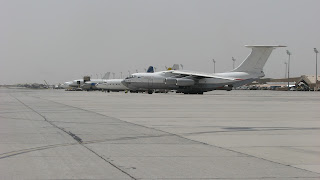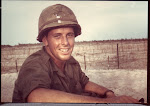BAGRAM, AFGHANISTAN: When GIs on missions among the valleys and mountains of Afghanistan run into more firepower than he can handle, almost instant fire support is available. The 455th Air Expeditionary Wing based at Bagram Airfield has F-15Es, that are normally based in Lakenheath, England. These aircraft can be in the air in 15 minuets and with a top speed of 2.5 Mach, be anywhere in the country in very short order.
 |
| Col. Mike Kelley, Vice Wing Commander with one of his F-15Es being readied for flight at Bagram Airfield, Afghanistan |
For air support in the general area of Bagram, a fleet of slower A-10 Warthogs is available. These aircraft are from a Pennsylvania National Guard Unit. Bagram is also the principle point of entry
for nearly all of the supplies needed for the ISAF (International Security Assistance Force) operations in this landlocked country.
Col. Mike Kelley, a 20 year F-15 pilot, is the
Vice-Commander of the 455th Air Expeditionary Wing. Even though the US Army controls this base, which in itself is highly unusual, Col. Kelley’s responsibilities, beyond his duties as Vice Wing Commander, requires an extensive knowledge of all air operations on the field.
“We have a three hour turnaround for all of the aircraft who are delivering freight and/or personnel, otherwise this ramp would be unmanageable. This base was built by the Russians and if you notice most of the civilian air freight contractors use Russian aircraft to supply American forces. Quite a twist, isn’t it?”
In country air support for transporting personnel and shipping supplies to the larger military installations, is provided by a fleet of C-130s which at the moment are provided by National Guard Units from Maryland, California and Rhode Island. There’s also a Helicopter Rescue Unit from Alaska.
“We have ‘Blackwater’ in Afghanistan also,” said Col. Kelley. “However their mission is air
support for the smaller FOBs (Forward Operating Bases) through their subsidiary, ‘Presidential Airway’s. They maintain and operate a fleet of smaller twin engine turbine aircraft with which they are accomplishing their mission very effectively. I have heard though, that the Army and Air Force are going to form a joint command unit using the CASA short take off and landing aircraft, sort of a miniature C-130, to take over that mission and keep it under direct military control.”
The 11,500 ft. airstrip on this airfield, which sits at an elevation of 5,000 ft. above sea level, is brand new. The old, Russian built, concrete strip is used as a taxiway and ramp. The quality of the old strip was such that, sophisticated aircraft such as the F-15E were not able to safely operate from its surface. Pieces of lose concrete were being sucked up into the engines.
On the Eastern side of the airfield, Weapon’s Officer, Capt. M.S, call sign ‘Cleo’ is pre flighting her F-15E. She’s being assisted by the pilot, Capt. J.A., call sign ‘Spike’. They are just beginning their 12 hour alert cycle. “As Weapons Officer, I’ve got to check every bomb to see that they’re armed and safe. Some are laser guided, some are GPS, and others are routine ordinance” said ‘Cleo’. “Since we’ve got to be in the air in 15 minuets after a request for support is called in, just everything has to be set.”
Fuel, mechanicals, electronics, computers, chutes, tires, cannons; the list goes on and on. Both ‘Cleo’ and ‘Spike’ gradually cover the whole of the exterior and interior of the craft. While this is going on, ‘Cleo’ is being interviewed and filmed by CBS Sixty Minuets cameraman, Adil Bradlow who is in Afghanistan preparing for a segment to be aired in Sept. with Laura Logan.
Adil, who has covered every hotspot in Africa, The Balkans and the Middle East over the last 20 years for CNN or the AP, intends to use this footage on the CBS website.
“This should make a great piece,” he said. “That ‘Cleo’ knows everything about that plane and articulated every specific so clearly and concisely. Plus she’s a natural for the camera…and she’s very pretty.”
Wing Vice-Commander Col. Kelley has one extremely important piece of advice that he offers to every new pilot that joins his command. In his opinion it’s the key to winning support for any kind of counter-insurgency conflict. It’s the reason he stresses that a bomb should never be dropped until the target has been identified as ‘the bad guys’, with absolute certainty.
“The bombs you drop will never be the ones that win this war”, says Col. Kelley, “but they could very easily be the ones that lose it.”
Col. Mike Kelley, a 20 year F-15 pilot, is the
Vice-Commander of the 455th Air Expeditionary Wing. Even though the US Army controls this base, which in itself is highly unusual, Col. Kelley’s responsibilities, beyond his duties as Vice Wing Commander, requires an extensive knowledge of all air operations on the field.
“We have a three hour turnaround for all of the aircraft who are delivering freight and/or personnel, otherwise this ramp would be unmanageable. This base was built by the Russians and if you notice most of the civilian air freight contractors use Russian aircraft to supply American forces. Quite a twist, isn’t it?”
 |
| Capt. 'Cleo', F-15E Weapons Officer pre flighting her aircraft while being filmed by 60 Minutes cameraman Adil Bradlow. |
“We have ‘Blackwater’ in Afghanistan also,” said Col. Kelley. “However their mission is air
support for the smaller FOBs (Forward Operating Bases) through their subsidiary, ‘Presidential Airway’s. They maintain and operate a fleet of smaller twin engine turbine aircraft with which they are accomplishing their mission very effectively. I have heard though, that the Army and Air Force are going to form a joint command unit using the CASA short take off and landing aircraft, sort of a miniature C-130, to take over that mission and keep it under direct military control.”
The 11,500 ft. airstrip on this airfield, which sits at an elevation of 5,000 ft. above sea level, is brand new. The old, Russian built, concrete strip is used as a taxiway and ramp. The quality of the old strip was such that, sophisticated aircraft such as the F-15E were not able to safely operate from its surface. Pieces of lose concrete were being sucked up into the engines.
On the Eastern side of the airfield, Weapon’s Officer, Capt. M.S, call sign ‘Cleo’ is pre flighting her F-15E. She’s being assisted by the pilot, Capt. J.A., call sign ‘Spike’. They are just beginning their 12 hour alert cycle. “As Weapons Officer, I’ve got to check every bomb to see that they’re armed and safe. Some are laser guided, some are GPS, and others are routine ordinance” said ‘Cleo’. “Since we’ve got to be in the air in 15 minuets after a request for support is called in, just everything has to be set.”
 |
| Capt. 'Cleo', F-15E Weapons Officer pre flighting her aircraft while being filmed by 60 Minutes cameraman Adil Bradlow. |
Fuel, mechanicals, electronics, computers, chutes, tires, cannons; the list goes on and on. Both ‘Cleo’ and ‘Spike’ gradually cover the whole of the exterior and interior of the craft. While this is going on, ‘Cleo’ is being interviewed and filmed by CBS Sixty Minuets cameraman, Adil Bradlow who is in Afghanistan preparing for a segment to be aired in Sept. with Laura Logan.
Adil, who has covered every hotspot in Africa, The Balkans and the Middle East over the last 20 years for CNN or the AP, intends to use this footage on the CBS website.
“This should make a great piece,” he said. “That ‘Cleo’ knows everything about that plane and articulated every specific so clearly and concisely. Plus she’s a natural for the camera…and she’s very pretty.”
 |
| Parking ramp at Bagram Airfield, Afghanistan. Russian Air Freighter is in the foreground. |
Wing Vice-Commander Col. Kelley has one extremely important piece of advice that he offers to every new pilot that joins his command. In his opinion it’s the key to winning support for any kind of counter-insurgency conflict. It’s the reason he stresses that a bomb should never be dropped until the target has been identified as ‘the bad guys’, with absolute certainty.
“The bombs you drop will never be the ones that win this war”, says Col. Kelley, “but they could very easily be the ones that lose it.”

No comments:
Post a Comment